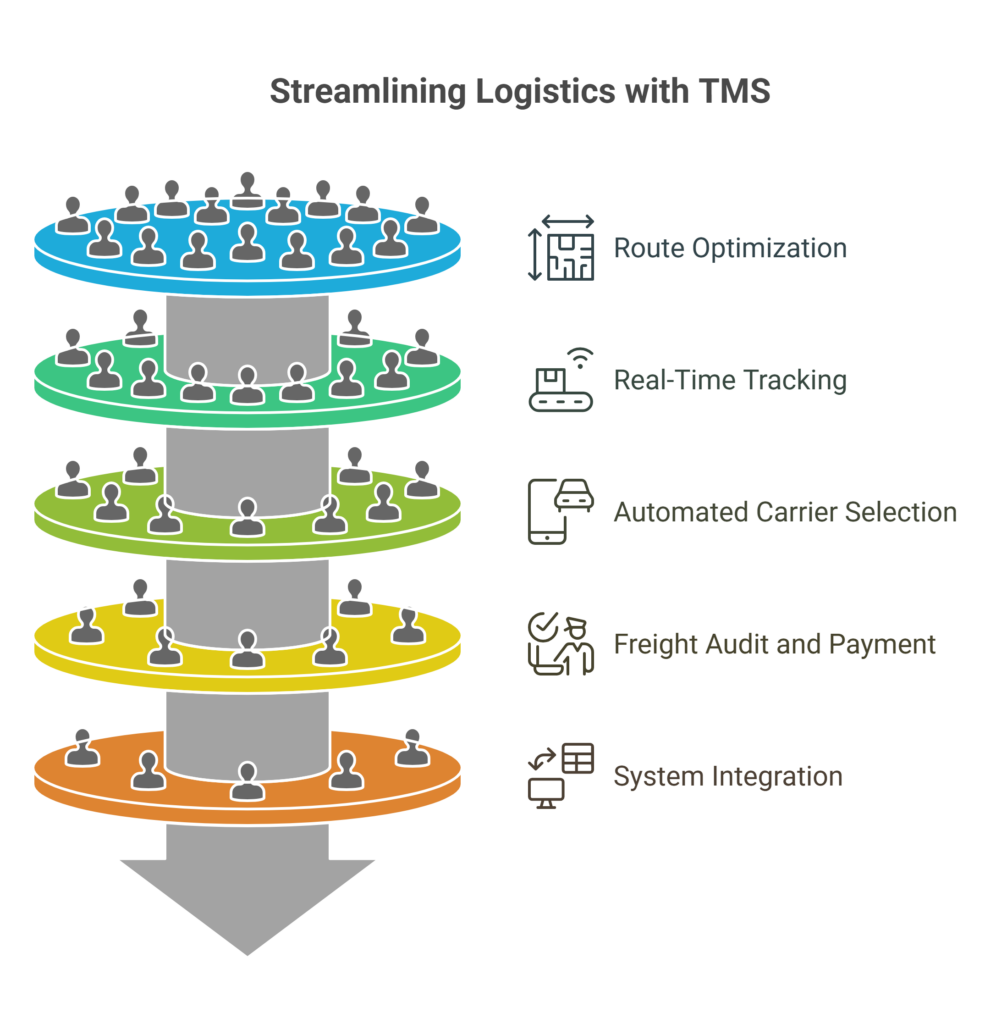Late or inaccurate deliveries cause more customer complaints than nearly any other supply chain issue. 😟 Shipping delays, unexpected costs, and a lack of real-time updates all threaten business reputations and profits. If your team still juggles spreadsheets and endless emails to coordinate shipments, you’re losing precious hours and missing out on strategic decisions. This piece clarifies how transportation management software (TMS) solves these pain points, streamlining logistics operations from planning to payment.
You’ll walk away knowing:
- How TMS automates and optimizes complex transportation tasks
- Which features matter most for shippers, carriers, and logistics teams
- How Nektar.io can customize a TMS offering to your needs
What Is Transportation Management Software?
Transportation management software, or TMS, is a type of supply chain software designed for planning, executing, and optimizing the physical movement of goods. Think of it as the central nervous system for your shipping operations. It’s different from systems like warehouse management (WMS), which focuses on what happens inside the four walls of your warehouse, or order management systems (OMS). TMS specifically addresses the challenges of both inbound (goods coming to you) and outbound (goods going to customers) logistics. It helps manage everything from the moment a shipment is planned until it’s delivered and paid for.
This kind of software fits within the broader logistics technology picture, supporting company-wide management and the smooth flow of goods. As Manhattan Associates puts it, “A transportation management system (TMS) is a supply chain software [offering] that enables enterprise-wide management, optimization, planning, and execution of logistics services for transporting goods in both inbound and outbound movement.” It’s about making sure your products get where they need to go, efficiently and effectively.
“A transportation management system (TMS) is a supply chain software solution that enables enterprise-wide management, optimization, planning, and execution of logistics services for transporting goods in both inbound and outbound movement.” -Manhattan Associates
Core Benefits of Transportation Management Software
The business outcomes from using a TMS are pretty compelling. Companies often see big improvements in efficiency because many manual steps are automated. Cost savings are another major plus, often achieved through smarter routing or better carrier choices. Customer service gets a lift too, with more accurate delivery information and fewer surprises. Plus, staying on top of compliance becomes easier. For instance, a TMS can help reduce route miles through optimization, or automate the creation of shipping documents, saving both time and money. 🚚
Making decisions based on solid data is a key advantage. A TMS provides the information needed to refine day-to-day operations continually. According to AutoStore, “A TMS helps identify the most cost-effective shipping options, taking into account variables like routes, carriers, and shipment sizes.” Furthermore, Inbound Logistics notes that “Transportation management systems automate many manual tasks involved in supply chain planning and execution, such as route optimization and shipment tracking, saving time and reducing errors.” This data-driven approach means smarter choices and better performance across the board.
“A TMS helps identify the most cost-effective shipping options, taking into account variables like routes, carriers, and shipment sizes.” -AutoStore
“Transportation management systems automate many manual tasks involved in supply chain planning and execution, such as route optimization and shipment tracking, saving time and reducing errors.” -Inbound Logistics
Essential Features of Modern TMS
When looking at TMS platforms, certain features are must-haves for any logistics team aiming to cut costs, reduce errors, and lessen manual workloads. Route optimization is a big one, finding the best paths for shipments. Real-time tracking gives everyone visibility into where shipments are at any moment. Automated carrier selection helps pick the right carrier for the job based on cost, service, and other factors. Freight audit and payment features streamline the financial side, making sure bills are accurate and paid on time. Integration with other business systems, like WMS or Enterprise Resource Planning (ERP) software, is crucial for a unified view of operations. And, of course, data analytics dashboards provide the insights needed to see how things are going and where improvements can be made. 📊
Automation plays a huge part in what makes a TMS so powerful. It takes over repetitive tasks, freeing up your team for more strategic work. Imagine systems that automatically suggest the best carrier or flag potential issues before they become major problems. This isn’t just about saving time; it’s about making the entire logistics process smarter and more resilient.

The latest advancements like machine learning, the Internet of Things (IoT), and cloud integrations are really taking TMS capabilities to the next level. Machine learning can refine route optimization over time, IoT devices can provide pinpoint location data for assets, and cloud platforms offer scalability and accessibility. As Warehousing and Fulfillment states, “With features like route optimization, freight consolidation, and real-time tracking, businesses can maximize asset utilization, minimize empty miles, and speed up deliveries.” These technologies are making TMS platforms more intelligent and responsive than ever before.
“With features like route optimization, freight consolidation, and real-time tracking, businesses can maximize asset utilization, minimize empty miles, and speed up deliveries.” -Warehousing and Fulfillment
How Transportation Management Software Improves Efficiency
One of the most immediate impacts of a TMS is on operational efficiency. By taking over manual processes, cutting down on paperwork, and improving communication between internal teams and external partners, a TMS can make a real difference. Think about the time spent chasing down information, manually entering data, or trying to coordinate with carriers via phone and email. A TMS streamlines much of this. 🚀
Descartes highlights this well: “By automating transportation-related processes like automated carrier selection, automated communication with carriers/forwarders, automatic document creation, etc., a TMS can help companies reduce the amount of time and resources required to manage their transportation operations.” This means your team can achieve more with less effort, reducing administrative overhead and focusing on higher-value activities. Instant carrier selection based on predefined rules, or automatically generated shipping labels and bills of lading, are just a couple of ways efficiency gets a boost.
“By automating transportation-related processes like automated carrier selection, automated communication with carriers/forwarders, automatic document creation, etc., a TMS can help companies reduce the amount of time and resources required to manage their transportation operations.” -Descartes
Cost Reductions and ROI from TMS
A TMS directly helps lower freight spending in several ways. Smart route optimization means fewer miles driven, which saves on fuel and wear and tear. Load consolidation combines smaller shipments into fuller, more economical loads. Better use of carrier contracts ensures you’re getting the best rates you’ve negotiated. These factors add up, leading to noticeable reductions in overall transportation costs, including savings on fuel, tolls, and vehicle maintenance. 💰
The return on investment (ROI) from a TMS can be quite attractive. Modern cloud-based TMS platforms, like those offered by Nektar.io, often mean faster launches and a lower total cost of ownership compared to older, on-premise systems. As Oracle points out, “A cloud-based transportation management system delivers many of the same business benefits as other cloud [offerings], including improved economies of scale, lower total cost of ownership, no upgrade fees, and a faster return on investment.” This makes adopting a TMS more accessible and quicker to show value.
“A cloud-based transportation management system delivers many of the same business benefits as other cloud solutions, including improved economies of scale, lower total cost of ownership, no upgrade fees, and a faster return on investment.” -Oracle
Customer Service Advantages with TMS
Happy customers are repeat customers, and a TMS plays a big part in keeping them happy. Shippers can provide real-time updates on where orders are, give more accurate estimated times of arrival (ETAs), and proactively notify customers if there’s an unexpected delay. This level of communication reduces those “Where is my order?” calls and builds trust and loyalty. 😊
Transparency is key. When customers can track their shipments in real time or receive automated notifications about progress or changes, they feel more in control and better served. Inbound Logistics notes, “With TMS software, companies can provide more accurate and up-to-date information about shipments to their customers, including real-time tracking and delivery status.” This improved experience can be a real differentiator for your business.
“With TMS software, companies can provide more accurate and up-to-date information about shipments to their customers, including real-time tracking and delivery status.” -Inbound Logistics
Data-Driven Decisions and Visibility
A TMS is a goldmine of data. It gathers information on shipment metrics, carrier performance, cost analyses, and much more, then presents it as actionable insights. Dashboards and reporting tools make it easy to see what’s happening at a glance, while automated alerts can flag issues that need attention. This means faster, better-informed choices for your logistics team. You can spot trends, identify areas for improvement, and measure the impact of changes you make.
Real-time visibility doesn’t just help with customer service; it also drives accountability and allows for quick issue resolution. If a shipment is delayed or a problem arises, you know about it sooner and can take action before it escalates into a bigger disruption. Descartes mentions, “A TMS can provide companies with valuable data and insights into their transportation operations, such as carrier performance, shipping costs, delivery times, and compliance insights. This information can be used to make data-driven decisions that improve supply chain performance and optimize transportation operations.”

“A TMS can provide companies with valuable data and insights into their transportation operations, such as carrier performance, shipping costs, delivery times, and compliance insights. This information can be used to make data-driven decisions that improve supply chain performance and optimize transportation operations.” -Descartes
Regulatory Compliance and Risk Mitigation
Staying compliant with a web of industry regulations, safety standards, and contractual requirements can be complex. Transportation management software helps businesses maintain good standing, reducing the risks of fines, penalties, and delivery interruptions. Features like automated documentation ensure that the correct paperwork is always generated and stored, while audit capabilities make it easier to demonstrate compliance when needed. This helps keep your operations smooth and above board. ✅
Collaboration Across Supply Chain Partners
Logistics isn’t a solo game; it requires close coordination among many players. A TMS fosters better teamwork between shippers, carriers, brokers, and even suppliers. By providing a shared platform for information and workflows, it streamlines handoffs and improves overall reliability. Everyone is working from the same playbook, which reduces misunderstandings and delays.
Imagine a scenario where there’s a sudden spike in demand, or an unexpected route disruption due to weather. With a TMS, shared data and collaborative workflows help all parties react quickly and effectively to these challenges. As Descartes says, “A TMS can help improve collaboration between different departments within a company and with external partners such as carriers, brokers and suppliers. This can lead to better coordination and more efficient supply chain operations.” This teamwork is vital for navigating the complexities of modern supply chains.
“A TMS can help improve collaboration between different departments within a company and with external partners such as carriers, brokers and suppliers. This can lead to better coordination and more efficient supply chain operations.” -Descartes
Technology Trends Impacting TMS (AI, IoT, Cloud)
The technology behind TMS is constantly advancing. Innovations like AI-driven route optimization are making planning more precise than ever. IoT-based asset tracking provides granular, real-time location data for trucks and cargo. Machine learning analytics can uncover hidden patterns in your data to predict potential issues or suggest improvements. And cloud-native platforms offer unparalleled scalability, security, and accessibility. These advancements make TMS platforms more powerful and easier to use, leading to faster decisions and better outcomes. Oracle notes, “Machine learning enables TMSs to be more intelligent, providing better recommendations and more accurate predictions.” 🤖
“Machine learning enables TMSs to be more intelligent, providing better recommendations and more accurate predictions.” -Oracle
Future-ready TMS platforms, such as the advanced offerings from Nektar.io, provide distinct advantages over older, on-premises systems. They are typically more flexible, easier to update, and can integrate more readily with other modern technologies. This forward-looking approach ensures your logistics operations can adapt to changing market conditions and new opportunities.
Selecting the Right Transportation Management Software
Choosing a TMS is an important step. Key selection criteria include scalability (can it grow with your business?), integration capabilities (will it work with your existing systems?), user experience (is it easy for your team to use?), vendor support, and how well it fits your particular industry and business goals. It’s wise to compare different vendor options and clearly match features to what your business uniquely needs to achieve.
Sticking with outdated legacy systems or siloed spreadsheets can put your business at a disadvantage. These older methods often lack the visibility, automation, and analytical power of a modern TMS, leading to inefficiencies and missed opportunities. As Hogs Live aptly puts it, “Selecting a Transportation Management System (TMS) is a crucial decision that can have long-term consequences for a company’s operations. The modern market offers a wide range of [offerings], so it is essential to thoroughly analyze your needs and available options.”
“Selecting a Transportation Management System (TMS) is a crucial decision that can have long-term consequences for a company’s operations. The modern market offers a wide range of solutions, so it is essential to thoroughly analyze your needs and available options.” -Hogs Live
Integrating TMS with Other Logistics and Supply Chain Systems
For truly seamless operations, integrating your TMS with other key business software like ERP, WMS, and order management systems is a best practice. This creates end-to-end process visibility, meaning information flows smoothly from one system to another without manual re-entry or data silos. When your sales team, warehouse crew, and transportation planners are all looking at consistent, up-to-date information, everyone works more efficiently.
Unified data and workflows across these systems greatly reduce the chance of errors and make your entire supply chain more agile. You can respond faster to changes in customer demand or unexpected disruptions. Manhattan Associates highlights this synergy: “Having TMS and WMS working symbiotically in a unified platform unlocks end-to-end supply chain agility, visibility, and collaboration.” This interconnectedness is a hallmark of a well-optimized logistics operation.
“Having TMS and WMS working symbiotically in a unified platform unlocks end-to-end supply chain agility, visibility, and collaboration.” -Manhattan Associates
Why Choose Nektar.io for Transportation Management Software?
When it comes to transportation management software, Nektar.io brings a fresh and effective approach. We believe that your TMS should fit your business, not the other way around. That’s why we focus on providing systems that can be customized to your unique operational flows and strategic objectives. Our commitment is to help you get the most out of your logistics technology. ✨
Nektar.io stands out with strengths like highly adaptable configuration options, powerful analytics that turn data into clear actions, and a modern, cloud-based deployment model for flexibility and scalability. We back this up with dedicated customer support, ready to assist you in meeting even the most complex logistics needs. If you’re looking for a partner to help you manage your transportation more effectively, Nektar.io has the expertise and the technology to make it happen.

FAQ: Transportation Management Software
What is transportation management software used for?
It’s primarily used for the core tasks of moving goods: planning shipments, executing those plans (like tendering loads to carriers and tracking progress), and optimizing transportation activities to improve efficiency and reduce costs.
How does TMS differ from WMS?
A TMS focuses on the movement of goods *outside* the warehouse – planning routes, selecting carriers, tracking shipments in transit. A WMS (Warehouse Management System) manages activities *inside* the warehouse – inventory control, order picking, and storage. Both are vital for a smooth supply chain, but they cover different areas.
Does TMS support real-time tracking?
Yes, absolutely! Real-time shipment visibility is a cornerstone feature of most modern TMS platforms. This allows shippers, carriers, and sometimes even customers to see the current location and status of shipments.
What are the top benefits of TMS for shippers and carriers?
For shippers, key benefits include reduced freight costs, improved efficiency through automation, better customer service via accurate ETAs, and easier compliance. Carriers benefit from better load visibility, optimized routes, streamlined communication, and faster payment cycles.
How do I get TMS into my business?
Typically, this involves assessing your current needs, selecting a TMS vendor (like Nektar.io! 😉), configuring the software to your processes, integrating it with other systems if needed, training your team, and then going live. A good vendor will guide you through this process.
Conclusion
Transportation management software has become absolutely vital for companies aiming to control costs, deliver superior customer experiences, and gain a competitive edge in logistics. By automating everything from route planning to payment audits, TMS platforms help businesses eliminate waste, improve agility, and make smarter, data-driven decisions. When you choose a partner like Nektar.io, you get advanced technology and expert support shaped to your unique transportation challenges.
Ready to see how transportation management software can upgrade your logistics operations? Contact Nektar.io today for a personalized demo and discover how their offerings can help you reach your goals faster. 🚀
Key Takeaways:
- Transportation management software streamlines logistics, boosts efficiency, and reduces operational costs.
- Critical features include route optimization, real-time tracking, and automated documentation.
- Modern TMS platforms enable better data-driven decisions, regulatory compliance, and partner collaboration.
- Nektar.io provides flexible, scalable TMS offerings to meet specialized business needs.



